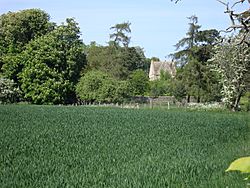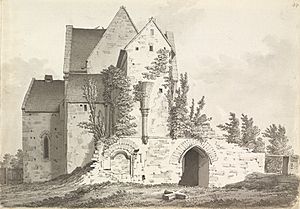Hinton Priory facts for kids
 |
|
| Monastery information | |
|---|---|
| Order | Carthusian |
| Established | 1227 |
| Disestablished | 1539 |
| People | |
| Founder(s) | Ela, Countess of Salisbury |
| Important associated figures | William Longspee, Earl of Salisbury |
| Site | |
| Location | Hinton Charterhouse, Somerset, England |
| Visible remains | buildings and earthworks |
| Public access | no |
Hinton Priory was a special kind of monastery called a Carthusian priory. It was located in Somerset, England, and was active for over 300 years, from 1232 to 1539. Monasteries were places where monks lived and prayed, dedicating their lives to God.
The Story of Hinton Priory
This priory was one of only ten Carthusian monasteries, also known as 'charterhouses,' that existed in England during the Middle Ages. It first started in 1222 in a place called Hatherop, Gloucestershire. A powerful noble, William Longspee, the Earl of Salisbury, founded it.
However, the monks did not like the first location. They wanted a quieter place to live and pray. After William Longspee died in 1226, they asked his wife, Ela, the Countess of Salisbury, for a new home. She gave them land in Hinton and Norton St Philip in Somerset.
The new priory was officially opened in May 1232. It was built about 1 kilometre (0.6 miles) northeast of the village of Hinton. The monks named it Locus Dei, which means 'God's Place'.
There was also a "lower house" built for the lay brothers. These were people who helped the monks but were not priests themselves. This lower house was near Freshford, close to the River Frome. It was about 1 kilometre (0.6 miles) to the east. The lower house was probably not used after the 1300s. After that, the lay brothers lived with the main community.
In 1529, Hinton Priory gained the land and property of a smaller monastery called Longleat Priory.
The priory was closed down on March 31, 1539. This happened during a time called the dissolution of the monasteries. King Henry VIII closed many monasteries in England. At that time, Hinton Priory was home to the Prior (the head monk), sixteen monks, and six lay brothers. After it closed, a man named Matthew Colthurst bought the property.
What Remains Today
Some parts of Hinton Priory still stand today. The chapter house, which was a meeting room, is still there. It also has a library and a dovecote (a place for doves) above it. This building is very important and is called a Grade I listed building. This means it has special historical importance.
The refectory, which was the dining hall, also survives and is Grade I listed. It is now part of a country house from the 1500s, also called Hinton Priory. This house is also a Grade I listed building. You can still see the outlines of the great cloister (a covered walkway) in the orchard and fields nearby.
The entire site is a Scheduled Ancient Monument. This means it is protected by law because of its historical value. It is also on the Heritage at Risk Register. This list shows historical sites that need care and attention. In 2012, its condition was described as "Poor."
Hinton Priory is on private land, so the public cannot visit it.
The site of the old "lower house" near the River Frome is also a scheduled monument. A small village there is still called "Friary," keeping the old name alive. You can still see earthworks and buried remains from the old buildings. A small house there even has parts of 14th-century stone walls. In 2017, a special sign was put up to show what the medieval buildings looked like.


